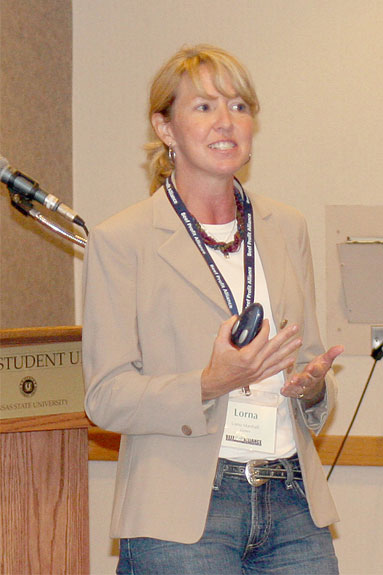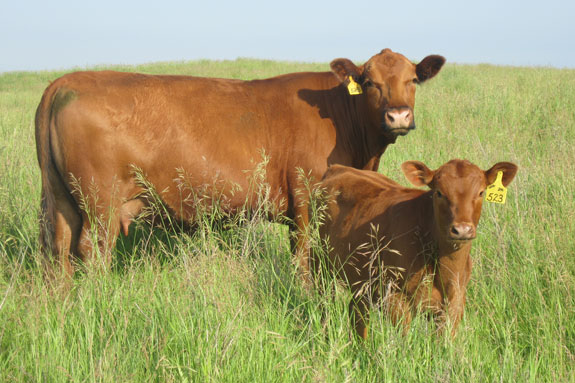The seminar – held at Kansas State University (KSU) in Manhattan, Kansas, July 22-24 – was a joint effort of the Red Angus Association of America (RAAA) and American Simmental Association (ASA).
While ASA and RAAA worked closely together to educate stakeholders, each maintained its own breed identity.
“We are here to learn what is relevant to serve the beef industry and our commercial customers,” said Greg Comstock, RAAA CEO. “We want to continue the ‘co-opetition’ between our two breeds. It makes us each work harder for market share.”

The future of EPDs
Jennifer Bormann and Dan Moser, both of KSU, reflected on the historical process of understanding genetic selection.
“The basic problem with genotype,” said Bormann, “is that it is unknown. Our goal – through DNA – is to increase the reliability with which we predict genetic merit.”
EPDs are the best prediction of an animal’s genotype. Through advancements in technology, breed associations are capable of combining pedigree information with genomics and phenotype – those traits that can be measured – into a more reliable EPD with increased accuracy in younger cattle.
Larry Keenan, RAAA director of breed improvement, and Lauren Hyde, ASA genetic evaluation programming specialist, expounded on the DNA process from a breed association perspective.
“DNA test results are just another piece of information – it doesn’t describe the entire genotype of an animal,” said Hyde. “But it works with the other data to bring producers more accurate EPDs earlier in an animal’s life.”
Incorporating DNA information into EPD calculations will provide producers with additional information, in a language they already understand, to assist in breeding decisions.
Starting with this fall’s National Cattle Evaluation (NCE) run of EPDs, producers will also be able to evaluate growth and carcass traits on all Red Angus and Simmental cattle on the same multi-breed EPD base and scale.

“Our collaboration has resulted in the world’s largest multi-breed dataset with over 10 million animals,” said Keenan.
“Commercial customers will be able to directly compare EPDs across the two breeds as well as registered hybrid seedstock.”
“I am proud of how these two associations are working together for the common good of their members,” said attendee John Callaway, Callaway Cattle Co., Hogansville, Georgia.
“Both breeds are indeed science-based and industry-focused with profit potential in mind.”
Do selection indexes work?
Wade Shafer, ASA COO and director of performance programs, reminded attendees that the goal and purpose of Beef Profit Alliance was to improve the profit of their customer – the commercial cattle producer.
“Selection indexes are basically genetic accounting,” said Shafer. “We combine the values of a suite of complementary traits to give commercial ranchers a simplified number to assist them in bull selection.”
A lot of science goes into developing an economic index, which is measured as a dollar value. ASA currently provides two indexes – All-Purpose Index (API) and Terminal Index (TI) – to offer customers a simplified number on which to base their seedstock selection.
Jim Butcher, Gateway Simmentals, Lewistown, Montana, uses indexes to make his genetic selections and reinforces their value to his customers.
“Indexes are just one of the tools we use – and encourage our customers to use – to be successful. They’re not perfect, but they’re the best selection tool we’ve ever had,” stated Butcher.
His customers appreciate the simplicity of indexes in their seedstock-buying decisions and, if they want to place more selection pressure on a specific area, Butcher encourages them to study individual EPDs.
The seedstock supplier’s role
Even with the advancements in technology and evaluation tools such as EPDs and indexes, Lorna Marshall, Genex/CRI, of Burlington, Colorado, believes form follows function and conformation traits still play a role in selection decisions.
Stature, body capacity, structural soundness and udder quality all contribute to a cow’s longevity – and therefore profitability. “Body traits are highly heritable at 31 to 42 percent,” said Marshall.
She encouraged seedstock producers to discern conformation traits within their own herds, recording foot and leg structure, udder quality, disposition and body condition scores. “I’m not sure we want to publish more EPDs, but I foresee incorporating conformation traits into new or existing indexes.”

The future
Cattle production is a resource-intensive industry, according to Ronnie Green, University of Nebraska vice president and vice chancellor for the Institute of Agriculture and Natural Resources.
But farmers and ranchers are producing more food with less of these resources than ever before.
He predicts a rapid decline in land-grant universities relevant to beef production in the next 10 years.
“We absolutely need to be encouraging the best and brightest students into agriculture,” said Green. “From production all the way up through the value chain in all fields of study.”
He also challenged beef producers to be students of the new genetic evaluation tools to become more accurate in assessing an animal’s worth.
Ken Odde, KSU professor and department head of animal sciences and industry, reinforced Green’s concern.
“We will not be successful as a supplier of beef to this growing population if we are not competitive,” he stated at the conclusion of the conference. “We must invest in research to become – and remain – globally competitive.”
“In this business, everything is about margin,” said Kevin Unger, manager, Decatur Co. Feed Yard, Oberlin, Kansas.
“The things that affect margin – health, feed efficiency, hot carcass weight and grade – are all driven by genetics. It’s exciting to see tools like indexes and DNA technology added to EPD models, as well as joint efforts such as the RAAA and ASA combined databases.”
Click here to view video coverage and slide presentations of each of the speakers. ![]()
—From Red Angus Association news release
PHOTOS
TOP: Lorna Marshall of Genex/CRI encouraged seedstock producers to discern conformation traits within their own herds.
MIDDLE: The new multi-breed EPDs for growth and carcass traits will help Red Angus and Simmental producers compare cattle in both breeds.
BOTTOM: Ronnie Green, University of Nebraska, said we absolutely need to be encouraging the best and brightest students into agriculture. Photos courtesy of Red Angus Association.







